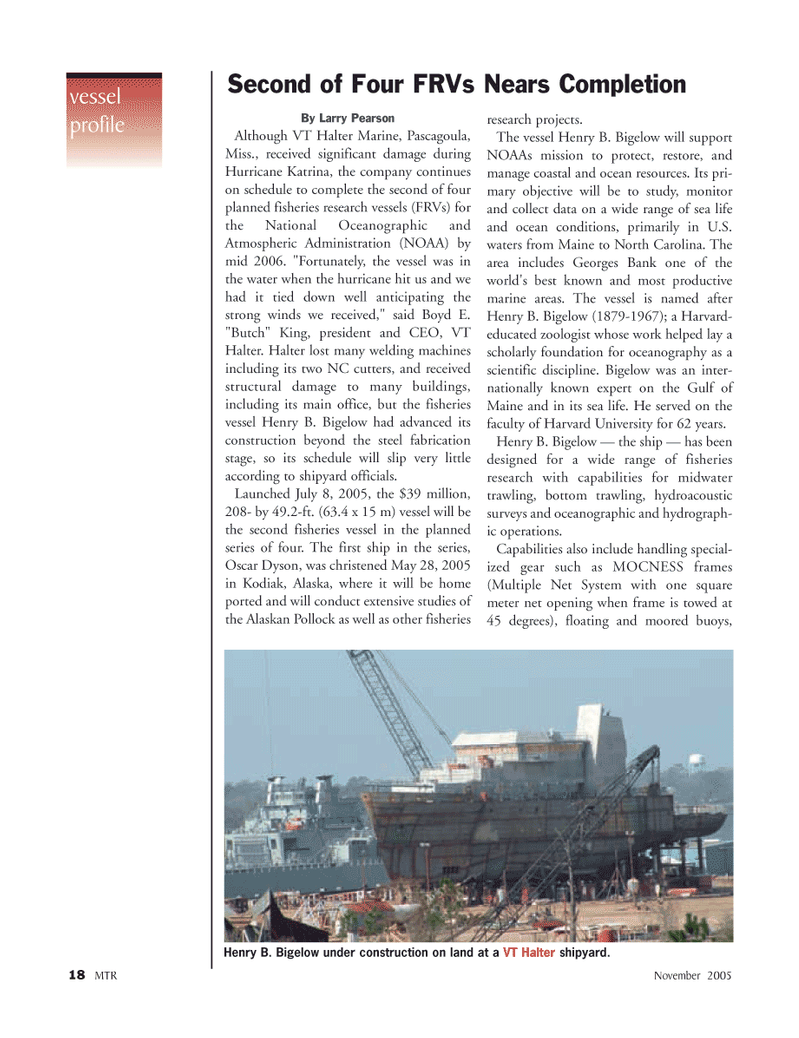
Page 18: of Marine Technology Magazine (November 2005)
Seafloor Engineering
Read this page in Pdf, Flash or Html5 edition of November 2005 Marine Technology Magazine
18 MTR November 2005
By Larry Pearson
Although VT Halter Marine, Pascagoula,
Miss., received significant damage during
Hurricane Katrina, the company continues on schedule to complete the second of four planned fisheries research vessels (FRVs) for the National Oceanographic and
Atmospheric Administration (NOAA) by mid 2006. "Fortunately, the vessel was in the water when the hurricane hit us and we had it tied down well anticipating the strong winds we received," said Boyd E. "Butch" King, president and CEO, VT
Halter. Halter lost many welding machines including its two NC cutters, and received structural damage to many buildings, including its main office, but the fisheries vessel Henry B. Bigelow had advanced its construction beyond the steel fabrication stage, so its schedule will slip very little according to shipyard officials.
Launched July 8, 2005, the $39 million, 208- by 49.2-ft. (63.4 x 15 m) vessel will be the second fisheries vessel in the planned series of four. The first ship in the series,
Oscar Dyson, was christened May 28, 2005 in Kodiak, Alaska, where it will be home ported and will conduct extensive studies of the Alaskan Pollock as well as other fisheries research projects.
The vessel Henry B. Bigelow will support
NOAAs mission to protect, restore, and manage coastal and ocean resources. Its pri- mary objective will be to study, monitor and collect data on a wide range of sea life and ocean conditions, primarily in U.S. waters from Maine to North Carolina. The area includes Georges Bank one of the world's best known and most productive marine areas. The vessel is named after
Henry B. Bigelow (1879-1967); a Harvard- educated zoologist whose work helped lay a scholarly foundation for oceanography as a scientific discipline. Bigelow was an inter- nationally known expert on the Gulf of
Maine and in its sea life. He served on the faculty of Harvard University for 62 years.
Henry B. Bigelow — the ship — has been designed for a wide range of fisheries research with capabilities for midwater trawling, bottom trawling, hydroacoustic surveys and oceanographic and hydrograph- ic operations.
Capabilities also include handling special- ized gear such as MOCNESS frames (Multiple Net System with one square meter net opening when frame is towed at 45 degrees), floating and moored buoys,
Second of Four FRVs Nears Completion vessel profile
Henry B. Bigelow under construction on land at a VT Halter shipyard.
MTR#3 (17-32).qxd 11/14/2005 12:49 PM Page 18

 17
17

 19
19
